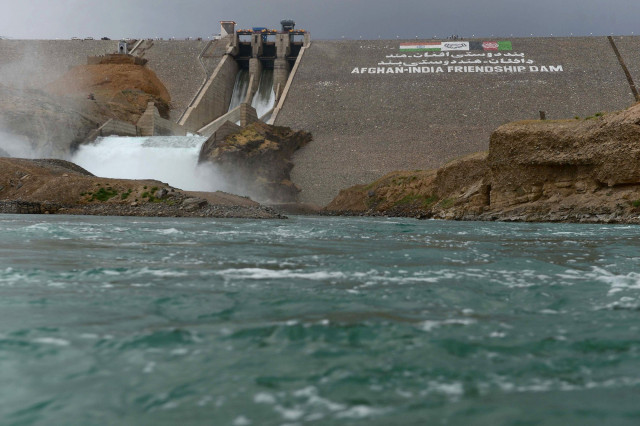The Kunar River rift
Afghan Taliban’s plan to build a dam on the Kunar River cause of worry for the two sides

With Pakistan’s relations with Afghanistan’s Taliban rulers already tense over their inaction against terror havens, the latter may be about to kick another potential hornets’ nest. The Emirate-e-Islami Afghanistan’s plan to begin building water reservoirs along the Kunar River in the province of the same name following the Qosh Tepa Canal's completion has sparked fresh worries in Islamabad.
The concerns, which come at a time when finger-pointing between the two sides is at an all-time high, were best reflected in a series of posts by Balochistan government’s spokesman Jan Achakzai on X, the social media platform formerly known as Twitter. “The Afghan Taliban's unilateral decision to establish a dam on the Kunar River, also known as the Chitral River, will be considered a hostile act against Pakistan,” he wrote, adding that “If the Afghan Taliban proceeds with this dam without involving Pakistan, it will have severe consequences escalating tensions and potential conflict.”
Regardless of their intentions, the Afghan Taliban could find it difficult to carry on with dam-building without Pakistan in its corner. The dam initiative would require huge financial investment and the support of the international community, both of which the Taliban regime currently does not have.
Islamabad announced a major policy shift in November last year, deciding it would cease advocating the Afghan Taliban’s case at the international level or extend any other assistance following failure of the Kabul authorities to neutralise the banned Tehreek-e-Taliban Pakistan (TTP). The dam announcement, as such, could be a response to both that move and the repatriation of Afghan refugees as the Taliban regime seeks to strengthen its hand in negotiations.
Tracing the source
Pakistan and Afghanistan share nine river basins, including three in Khyber-Pakhtunkhwa and six in Balochistan. The K-P rivers — Kabul, Gomal, and Kurram — flow from Afghanistan into the province. The Balochistan rivers include Pishin-Lora, Kandahar-Kand, Kadanai, Abdul Wahab stream and Kaiser River.
These basins are incredibly rich, with most of Khyber-Pakhtunkhwa's population residing around them. Additionally, over one-third of Afghanistan's population, totalling more than 43 million people, resides around these basins.
Collectively, the basins not only meet the needs of a sizeable population in both Pakistan and Afghanistan, but also in other neighbouring countries such as Iran, Tajikistan and Turkmenistan. Their strategic significance lies in the fact that almost all the populations of Afghanistan's neighboring countries rely solely on these rivers.
The Kabul River originates in Mastuj at Broghil Pass in Pakistan, referred to as the Mastuj River in Upper Chitral and as the Chitral River in Lower Chitral. Upon reaching Arundo at Chitral Lowari Tunnel, it enters Afghanistan's Kunar province and becomes the Kunar River. It merges with the Kabul nullah at Jalalabad, from whereon it is referred to as the Kabul River, and re-enters Pakistan at the Mohmand district.
About 80 per cent of the river remains in Afghanistan, while 20 per cent flows into Pakistan. Mastuj comprises more than fifty per cent of the Kabul River, making it a unique river in the world. Simultaneously, Afghanistan and Pakistan are both upstream and downstream, as well as upper and lower riparian.
During the signing of the Indus Waters Treaty, Pakistan and India included all rivers except the Kabul River, even though it converges with the Indus in Attock district. Afghanistan was not invited to be a part of that treaty and no other treaties on rivers were ever discussed between Kabul and Islamabad.
Unpacking water politics
It is a fact that Afghanistan serves as a significant water source for the region, and that its neighbouring countries grapple with water shortages. Afghanistan believes that it has ‘sole sovereignty over the water utilities’ of basin and that it has full authority over its use, storage, diversion, or wastage, sources told The Express Tribune. On the other hand, Pakistan and Iran, as lower riparian countries, assert claims based on historical presence and territorial integrity.
Historically, water usage was initially governed by customary practices, later influenced by colonial legacies, and upon Pakistan's formation, the border drawn between the two sides that Afghanistan never mutually accepted. There exists no water treaty between Pakistan and Afghanistan, with the current water usage being guided by customary practices.
However, Iran and Afghanistan have a treaty from 1973, allocating Iran a fixed ratio of water at 22 cubic meters per second, along with 4 cubic meters per second as goodwill gestures.
While Afghanistan claims to retain the right to construct dams and reservoirs based on sovereignty formulas, a "benefit-sharing formula" could mutually benefit both countries. International donor agencies have also sponsored such trans-border river projects on the global stage. Studies have also stressed that the issues faced by Pakistan and Iran predominantly stem from poor water management at domestic levels.
Notably, the disputes between Iran-Afghanistan and Pakistan-Afghanistan are primarily political rather than centred on water disputes. The waterways that flow into Pakistan and Iran from Afghanistan contribute significantly to regional agriculture, supplement water levels, create ponds, facilitate transportation and assist in managing waste. Their sources primarily rely on rainwater and glacier melting. However, climate change has drastically altered weather patterns, posing a severe threat to the region's water politics.
Working towards a solution
First, it's crucial to question whether Afghanistan truly needs a dam. Constructing a dam downstream on the Kabul River would be "useless," Dr Shakeel Hayat, the author of two books on shared waters between Afghanistan and Pakistan, told The Express Tribune. The energy generated wouldn't find much use due to low power consumption in the region. Selling excess energy is a challenge, he highlighted.
"For irrigation purposes, it's also ineffective," he continued, pointing out that the river passes through 18 districts and seven provinces where agriculture isn't substantial. Furthermore, floods recurrently affect these lands, making it impossible to transfer water to nearby provinces.
Moreover, in a worst-case scenario, constructing the dam wouldn't prevent annual floods but might exacerbate them, becoming an environmental hazard for the region, cautioned Dr Shakeel. In response to the dam, Pakistan could also consider diverting Chitral waters at the Arundo point into its territory, as this notion finds popularity in the area.
Strategically, Afghanistan could generate cheaper energy using their reservoirs. However, the majority of irrigation in downstream K-P depends on the Kabul River. Pakistan faces energy shortages, while Afghanistan heavily relies on food supplies, with around eighty per cent coming from Pakistan, K-P in particular.
A potential solution lies in an agreement between the two sides. K-P could provide food supplies to Afghanistan, while Afghanistan could supply energy to K-P and merged districts, establishing a bartering trade system.
However, if Afghanistan insists on absolute sovereignty, it might pose threats to the region's ecology. Pakistan, situated upstream in Chitral, could divert water to the Swat River in response. The best resolution would be for both countries to avoid using this issue for political leverage and instead adopt a mutually beneficial formula that serves both sides.



















COMMENTS
Comments are moderated and generally will be posted if they are on-topic and not abusive.
For more information, please see our Comments FAQ